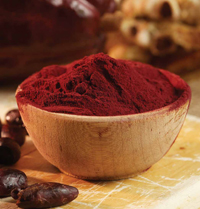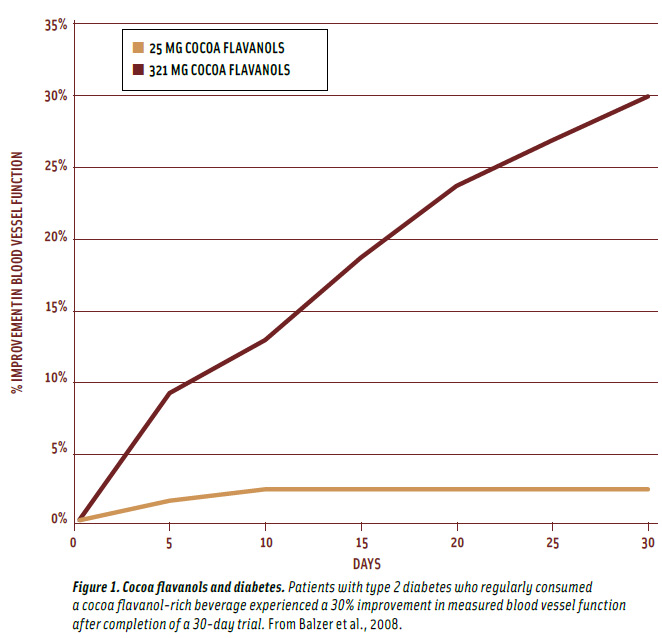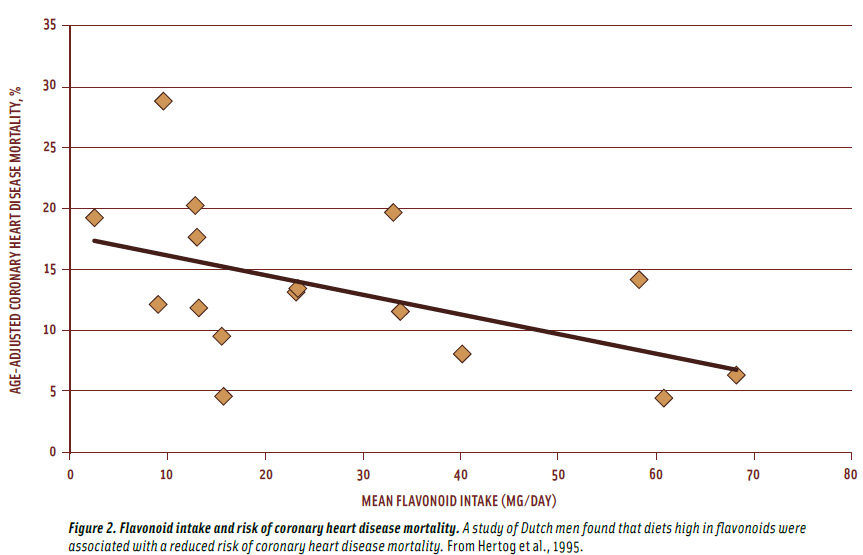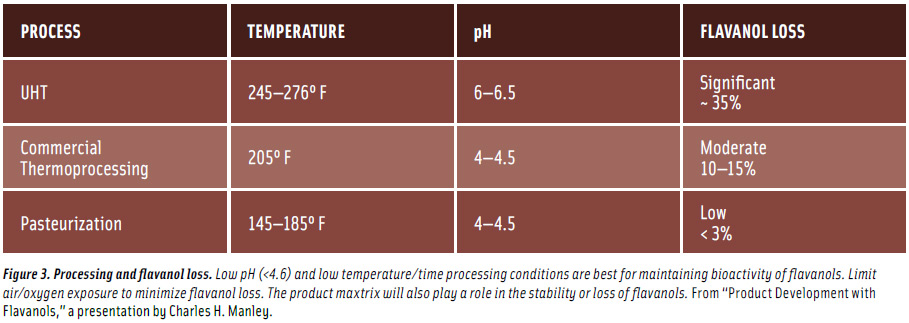Unlocking the Benefits of Cocoa Flavanols
Understanding cocoa flavanols and their mechanisms for health may drive development of the next generation of functional food products.
Increased consumption of fruits and vegetables is recommended as a means of reducing health risks, including cardiovascular and circulatory diseases (IFT, 2005). Both the World Health Organization (WHO) and Food and Agriculture Organization (FAO) support accumulating evidence which suggests that certain flavonoids derived from fruits and vegetables are important contributors to the improved health associated with fruit and vegetable consumption. Consequently, there is a growing research interest related to specific compounds from the flavonoid family that might contribute to this benefit. Flavanols found naturally in cocoa beans are also found in red wine and tea, although the concentrations of these phytochemicals can vary widely among these foods/beverages. A symposium presented at the 2009 IFT Annual Meeting in Anaheim, Calif., addressed some of the potential health benefits and applications of flavanols from cocoa and other natural sources and serves as the basis for this article.
Cocoa Flavonoids and Vascular Protection
Polyphenols (including flavanols) are typically consumed in substantial quantities compared with vitamins and other bioactive substances; it has been estimated that the average adult consumes about 1,000 mg/day of polyphenols, while only 12 mg of Vitamin E, 5 mg of carotenoids, and 90 mg of Vitamin C are ingested (Heber, 2009). Significant portions of the total polyphenols consumed by humans can be flavanols. While these polyphenols can be found throughout nature, they can be in particularly high concentrations in certain products such as cocoa powder, grape seeds, tea, wine, apples, and cranberries.
The bioavailability and bioactivity of flavanols, and their oligomers (procyanidins) differ depending on their chemical composition, isomeric form and chain length, their interactions with other components present in the food matrix, and their breakdown products following gut metabolism. The most common flavanol monomers in cocoa, catechin and epicatechin, show a peak presence in the bloodstream 1 to 2 hr after ingestion. Flavanol concentrations in the blood largely return to baseline values within 6 hr (Holt et al., 2002).
There is accumulating evidence that flavanol-rich foods can provide sustained health benefits. In this regard, studies with the Kuna Indians have been particularly intriguing. Unlike most populations in the Western world, the Kuna Indians residing on islands off the coast of Panama, isolated for the past 500 years, seem to have minimal health concerns related to hypertension or vascular diseases. Intriguingly, this indigenous group is characterized by a very low prevalence of age-related hypertension, with many individuals showing a stable, normalized blood pressure throughout their lifetime. Importantly, Kuna Indians who move inland to Panama City and the surrounding area have been reported to rapidly develop hypertension. Thus, its low prevalence on the islands cannot be simply attributed to genetics.

Studies of the diet consumed by the island Indians conducted by Hollenberg and others throughout the 1990s revealed a fascinating discovery regarding the consumption of cocoa on the islands. It was observed that the Kuna residing on the islands consume cocoa as their major drink daily, sometimes averaging more than 5 cups/day. It was also observed that due to a lack of processing, the cocoa consumed on the islands contained significantly higher amounts of flavanols than that found in most commercially available cocoa. These observations led to the hypothesis that cocoa flavanols might be responsible for the resistance to hypertension and cardiovascular disease (Hollenberg et al., 1997; Hollenberg et al., 1999).
--- PAGE BREAK ---
Putting Out the Fire Within
Experimental studies and further epidemiological studies have identified some of the positive acute and chronic effects associated with the consumption of flavanol-rich foods and purified flavanols. Plant flavanols, like most flavonoid compounds, have traditionally been touted for their antioxidant properties based on in vitro assays. However, the health benefits of flavanol-containing products such as cocoa, most notably the ones involving the circulatory system, do not appear to be dependent on the direct antioxidant properties of flavanols (Schroeter et al., 2006). The idea that flavanols might provide vascular protection through mechanisms other than acting as simple antioxidants is consistent with the observation that in numerous clinical trials, investigators have not been able to establish a link between classic antioxidants (such as Vitamin C) and a reduced risk of cardiovascular disease.
It is important to note that while flavanols may not be acting as direct antioxidants, their consumption might still be affecting the overall level of oxidative stress in some tissues. In this regard, it has been reported that when pre-diabetic rats were fed a diet of 30 mg/kg/day of flavanols for 12 weeks, there was a marked inhibition of NADPH oxidase activity in the aorta (Ihm et al., 2009). In theory, an inhibition of NADPH oxidase could be of major significance as this enzyme generates superoxide free radicals, which can contribute to the occurrence of tissue damage and inflammation, thus accelerating the development of many chronic diseases. Consistent with the above, while the consumption of a flavonoid-rich cocoa does not markedly alter the antioxidant capacity of the plasma, it can modulate circulation and decrease tissue inflammation (Heiss et al., 2007). It is now recognized that chronic inflammation in tissues can promote the development and progression of heart disease, certain cancers, and many other chronic diseases.
Recent studies indicate that one of the principal mechanisms of action responsible for the reduced risk of vascular disease associated with the consumption of diets rich in cocoa and its flavanols is the regulation of nitric oxide in the bloodstream. Yes, nitric oxide, the toxic pollutant gas produced by cigarette smoke and automobile engines, also occurs naturally in humans, and it is noted to play a significant role in increased vasodilatation and decreased platelet aggregation. The signaling molecule nitric oxide may be one primary mechanism involved in this process. Numerous other factors, including but not limited to effects on membrane structure/function, the immune system, and endothelium reactivity, appear to be involved in the inverse relationship between diets rich in plant-derived foods and vascular function. Consumption of high-flavanol cocoa beverages has shown similar effects as the known platelet inhibitor aspirin (Ding et al., 2006). For the most part, these effects were not observed in caffeine-containing beverages, signifying that the caffeine component of cocoa is not responsible for the observed effects on platelet aggregation (Pearson et al., 2005).
--- PAGE BREAK ---

The effects observed with experimental animal models and studies with healthy human adult subjects support the concept that consumption of flavanol-rich foods can result in acute (1–30 days) improvements in vascular health and blood flow. Study participants who consumed a flavanol-rich cocoa beverage experienced an impressive 30% improvement in measured blood vessel function at the completion of a 30-day trial (Balzer et al., 2008) (Figure 1). Several studies demonstrate that ingestion of cocoa high in flavanols increases blood flow to the brain (Sorond et al., 2008) and enhances endothelial functions (Schroeter et al., 2006; Fisher and Hollenberg, 2006). Short- and long-term effects of cocoa flavanols demonstrating enhanced brain blood flow have stimulated interest in the possible use of flavanol-rich foods and beverages in the prevention and treatment of cognitive decline and dementia.
A recent report by Balzer et al. (2008) suggests that flavanol-rich beverages may be of particular benefit for individuals suffering from type 2 diabetes, as subjects who consumed a flavanol-rich cocoa for 30 days were characterized by marked improvements in endothelial function. It is important to note that other food and beverage products rich in flavanols (e.g., purple grape juice and tea) have been noted to provide vascular health effects similar to those observed for cocoa.
Recent epidemiological studies have indicated that the consumption of flavonoid-rich diets is associated with decreased risk of hypertension and decreased mortality from cardiovascular disease. The Zutphen study of a cohort of Dutch men reported that men with diets high in flavonoids had lower risk of death from coronary heart disease (Hertog et al., 1995) (Figure 2). Subsequent analysis of the cohort suggested that ingestion of cocoa at levels as low as 0.5–2.3 g/day, is associated with reduced systolic and diastolic blood pressure and reduced deaths from cardiovascular disease (Buijsse et al., 2006).
Decreased risk of coronary heart disease mortality is also reported in a 16-year study of 34,489 post-menopausal women; high intakes of flavanols and procyanidins were reported to be of particular value (Mink et al., 2007).
Similar to the flavanols, a major metabolic component of pomegranate ellagitannins, ellagic acid, is bioavailable to humans. Ellagic acid is found in the blood plasma for up to 6 hr, and in the urine for up to 24 hr. Ellagic acid metabolites (urolithins) formed by the breakdown of ellagitannins by the gut microflora may persist in the urine for up to 48 hr.
These compounds may localize in the prostate gland and have been shown to be effective in inhibiting the inflammatory pathway of prostate cancer cell lines in vitro. In 2006, Pantuck and others were the first to conduct a clinical trial of pomegranate juice on patients with recurrent prostate cancer and from this study reported statistically significant results on prostate-specific antigen (PSA) doubling time (Pantuck et al., 2006). The most common forms of flavanols in the diet are the epicatechins, catechins, gallocatechins, and epigallocatechins; the bioactivity of pomegranate ellagitannins is similar in part to that of flavanols.
Cocoa Flavanols and Food Product Development
The many apparent advantageous health effects associated with the consumption of cocoa flavanols have generated interest by the food industry in developing more innovative products containing cocoa and flavanol-rich cocoa extracts geared toward today’s health-conscious consumer. The availability of new minimally processed cocoa powders and flavanol-rich extracts are stimulating the development of many diverse functional food products. Such functional foods have no legal or regulatory definition, but a panel of experts has indicated in a recent IFT Expert Report, “Functional Foods: Opportunities and Challenges,” that the concept can include foods and food components that “provide health benefits beyond the basic nutrition provided by foods.” These foods and their components would include conventional foods, fortified, enriched/enhanced foods, and dietary supplements. The definition covers many types of food components, including such substances as the cocoa flavanols that provide bioactive components that have been, by extensive scientific research, identified to impart health benefits or desired physiological effects.
--- PAGE BREAK ---

The development of food and beverage products delivering cocoa flavanols and their inherent health benefits offers broad potential for their contribution to help maintain “healthy” circulation. Concentrated flavanol-rich cocoa extracts offer food product developers both the potential of building healthier products and the challenge of ensuring that the final products deliver the desired health benefits and consumer acceptance. A technically successful product containing efficacious amounts of cocoa flavanols is one where the chemistry and physics of all ingredients and processing parameters used in developing the product have been carefully considered.
As noted above, cocoa and flavanol-rich cocoa extracts typically comprise a mixture of monomeric and oligomeric forms of flavanols; however, the monomer, dimer, and trimer forms account for the major components present. As the food matrix is very complex, so are the potential interactions of cocoa flavanols with individual components of a product. Processing conditions, most notably pH and temperature treatments/fluctuations, may cause the flavanols to undergo isomerization. Different stereoisomers may show increased oxidation and polymerization reactions in food matrices and have significantly different biological activities upon consumption (Figure 3).
Potential chemical and physical interactions of flavanols during the application of these compounds in food products, such as their ability to actively bind protein and facilitate colloid and/or haze formation, must be considered. Likewise, the effects of flavanol-rich extracts on a product’s color, flavor profile (i.e., bitterness and astringency), and enzymatic browning potential (causing degradation of the compounds) must be considered in each individual food/beverage application.
A recent study published in the Journal of Food Science investigated the losses in flavanols as a function of pH in chocolate cakes by exchanging leavening agents (baking soda and baking powder). In this study, chocolate cake mixes containing baking powder (average pH 6.2) showed almost complete retention of flavanol contents after the baking process. Traditional cake mixes utilizing baking soda (pH above 8.3) showed almost no detectable monomeric flavanols after baking (Stahl et al., 2009).
Green teas, red wines, and grape seed extracts with high flavanol content should also be noted for their wide use in food applications and extensive research efforts in the area of polyphenols.
Regulatory Aspects of Flavanol Use
The first consideration when making claims about any food, ingredient, or component is to ensure it is safe to consume. In the United States, the Food and Drug Administration requires that an ingredient or component either be GRAS (generally recognized as safe) or an approved food additive. Products making claims around polyphenols such as flavanols are typically those derived from natural sources; however, if a company is interested in delivering higher levels in a food (such as with an extract), then it is required that the substance be safe and lawful at the levels necessary to justify the claim (CFR, 2006). The second consideration in making claims is to ensure that the claim is truthful, not misleading, and allowed by law.
There are several types of claims in the U.S. that companies may consider, including health, nutrient, and structure-function claims. Health claims, which require pre-market approval by the FDA, characterize the relationship between a substance and a disease or health-related condition. Nutrient content claims describe the relative or absolute level of a nutrient in a food (e.g., good source of calcium).To date, no flavanol health or nutrient content claims have been approved by the FDA. However, absolute nutrient content claims or factual claims, such as “Natural source of cocoa flavanols” and “Contains X mg of cocoa flavanols,” can be made for flavanols.
--- PAGE BREAK ---
Structure-function claims describe the relationship between the food/component and the structure or function of the body (primarily focused on normal, healthy individuals). Structure-function claims do not require pre-market approval but do require that the company have competent and reliable scientific evidence supporting the claim. Structure-function claims are allowed for products containing efficacious amounts of flavanols. In determining whether these claims are substantiated, the FDA would consider the meaning of the claim and the quality and totality of evidence behind the claim. Randomized, double-blind, placebo-controlled human studies are the gold standard for structure-function claims. A proper example of a structure-function claim for products containing cocoa flavanols is “helps to maintain healthy circulation.”
However, any claim made on cocoa flavanols must consider the entire nutritional composition of the product, and the level of flavanols should be consistent with the claim being made. Use of appropriate biomarkers is critical to consider when making claims.
For cardiovascular disease, those which are documented by FDA as proven endpoints for this condition include: blood pressure, total and LDL cholesterol, and some disease endpoints such as incidence of coronary events, cardiovascular death, etc. The American Heart Association routinely re-evaluates the evidence supporting a wide variety of cardiovascular markers. Endothelial function and coagulation factors are two markers whose strength of evidence is growing (Vasan, 2006; Kitta et al., 2009).
In summary, flavanols or any other emerging phytonutrient should be used in the product at a level consistent with the claim; the claim should be consistent with the strength of the science and properly qualified; it should be based on the most relevant biomarkers and measured using scientifically sound analytical methods.
Future Research Directions
As the functional food industry continues to play a major role in the health food market, product developers constantly seek new valueadded ingredients to appeal to the public’s interest and palate. The ongoing and emerging science of cocoa flavanols gives rise to a new industry niche sustained by sound science and innovation.
Future research must continue to explore GI tract metabolism and mechanisms of action upon absorption of cocoa flavanols/metabolites/breakdown products in the body, as well as the efficacious levels of cocoa flavanols throughout the shelf life of assorted products and production processes. Further assessment of the flavanols’ stability as correlated to interactions with other components of the food matrix may show promising new applications of these compounds to a variety of products and help to increase the general public’s consumption of these powerful phyto-nutrients.
Taylor C. Wallace, a Member of IFT, is a Ph.D. Candidate and Graduate Research Assistant, The Ohio State University, 2015 Fyffe Road, Columbus, OH 43210 ([email protected]).
Mary Wagner, Ph.D., a Fellow and Past President of IFT, is General Manager/Chief Technology Officer, Mars Botanical, 1330 Piccard Drive, Suite 203, Rockville, MD 20850 ([email protected]).
Gilbert Leveille, Ph.D., a Fellow and Past President of IFT, is Executive Director, Wrigley Science Institute, 23 Cambridge Ave., Denville, NJ 07834 ([email protected]).
Carl L. Keen, Ph.D., is Professor, Department of Nutrition, University of California Davis, 3135 Meyer Hall, One Shields Ave., Davis, CA 95616 ([email protected]).Catherine E. Woteki, Ph.D., a Professional Member of IFT, is Global Director of Scientific Affairs, Mars Inc., 6885 Elm Street, McLean, VA 22101 ([email protected]).
Catherine E. Woteki, Ph.D., a Professional Member of IFT, is Global Director of Scientific Affairs, Mars Inc., 6885 Elm Street, McLean, VA 22101 ([email protected]).
Charles Manley, Ph.D., a Fellow and Past President of IFT, is a Consultant, 115 Cupsaw Drive, Ringwood, NJ 07456 ([email protected]).
Steven W. Rizk, Ph.D., a Professional Member of IFT, is Director of Scientific and Regulatory Affairs, Mars Snackfood U.S., 800 High Street, Hackettstown, NJ 07840 ([email protected]).
David Heber, M.D., Ph.D., is Director, University of California Los Angeles Medical Center for Human Nutrition, Box 951742, 12-217 WH, Los Angeles, CA 90095-1742 ([email protected]).
Anil J. Shrikhande, Ph.D., a Professional Member of IFT, is Vice President Research & Development, Constellation Wine U.S., 12667 Road 24, Madera, CA 93637 ([email protected]).
References
Balzer, J., Rassaf, T., Heiss, C., Kleinbongard, P., Lauer, T., Merx, M., Heussen, N., Gross, H.B., Keen, C.L., Schroeter, H., and Kelm M. 2008. Sustained benefits in vascular function through flavanol-containing cocoa in medicated diabetic patients. J. Am. Coll. Cardiol. 51: 2141-49.
Buijsse, B., Feskens, E.J.M., Kok, F.J., and Kromhout, D. 2006. Cocoa intake, blood pressure, and cardiovascular mortality. Arch. Intern. Med. 166: 411-17.
CFR. 2006. Code of Federal Regulations. 21 CFR 101.14(b)(3)(ii).
Ding, E.L., Hutfless, S.M., Ding, X., and Girotra, S. 2006. Chocolate prevention of cardiovascular disease: A systematic review. Nutr. Metab. 3: 1-12.
Fisher, N.D.L. and Hollenberg, N.K. 2006. Aging and vascular responses to flavanol-rich cocoa. J. Hypertension. 24(8): 1575-80.
Heber, D. 2009. Putting out the fire within: pomegranates and plant flavanols effects beyond antioxidation. Presentation at the 2009 Ann. Mtg. Inst. Food Technologists, Anaheim, Calif., June 8.
Heiss, C., Finis, D., Kleinbongard, P., Hoffman, A., Rassaf, T., Kelm, M., and Sies, H. 2007. Sustained increase in flow-mediated dialation after daily intake of high-flavanol cocoa drink over 1 week. J. Cardiovasc. Pharmacol. 49(2): 74-80.
Hertog, M.G.L., Kromhout, D., Aravanis, C., Blackburn, H., Buzina, R., Fidanza, F., Giampaoli, S., Jansen, A., Menotti, A., Nedeljkovic, S., Pekkarinen, M., Simic, B.S., Toshima, H., Feskens, E.J.M., Hollman, P.C.H., and Katan, M.B. 1995. Flavonoid intake and long-term risk of coronary heart disease and cancer in the seven countries study. Arch. Intern. Med. 155: 381-86.
Hollenberg, N.K., Martinez, G., McCullough, M., Meinking, T., Passan, D., Preston, M., Rivera, A., Taplin, D., and Vicaria-Clement, M. 1997. Aging, acculturation, salt intake, and hypertension in the Kuna of Panama. Hypertension 29: 171-76.
Hollenberg, N.K., Rivera, A., Meinking, T., Martinez, G., McCullough, M., Passan, D., Preston, M., Taplin, D., and Vicaria-Clement,M. 1999. Age, renal perfusion and function in island-dwelling indigenous Kuna Amerinds of Panama. Nephron 82:131-38.
Holt, R.R., Lazarus, S.A., Sullards, M.C., Zhu, Q.Y., Schramm, D.D., Hammerstone, J.F., Fraga, C.G., Schmitz, H.H., and Keen, C.L. 2002. Procyanidin dimer B2 [epicatechin-( 4ß-8)-epicatechin] in human plasma after the consumption of a flavanol-rich cocoa. Am. J. Clin. Nutr. 76(4): 798-804.
IFT. 2005. Functional foods: Opportunities and challenges. An expert report of the Inst. of Food Technologists, Chicago, Ill.
Ihm, S.H., Lee, J.O., Kim, S.J., Seung, K.B., Schini-Kerth, V.B., Chang, K., and Oak, M.H. 2009. Catechin prevents endothelial dysfunction in the prediabetic stage of OLETF rats by reducing vascular NADPH oxidase activity and expression. Atherosclerosis (in press).
Kitta, Y., Obata, J., Nakamura, T., Hirano, M., Kodama, Y., Fuijoka, D., Saito, Y., Kawabata, K., Sano, K., Kobayashi, T., Yano, T., Nakamura, K., and Kugiyama, K. 2009. Persistent impairment of endothelial vasomotor function has a negative impact on outcome in patients with coronary artery disease. J. Amer. Coll. Cardiology 53: 323-330.
Mink, P.J., Scrafford, C.G., Barraj, L.M., Harnack, L., Hong, C.P., Nettleton, J.A., and Jacobs, D.R. 2007. Flavonoid intake and cardiovascular disease mortality: a prospective study in postmenopausal women. Am. J. Clin. Nutr. 85: 895-909.
Pantuck, A.J., Leppert, J.T., Aronson, W., Hong J., Banard, R.J., Seeram N., Liker, H., Wang, H., Elashoff, R., Heber, D., Aviram, M., Ignarro, L., and Belldegrun, A. 2006. Phase II study of pomegranate juice for men with rising prostate-specific antigen following surgery or radiation for prostate cancer. Clin. Cancer Res. 12: 4018-26.
Pearson, D.A., Holt, R.R., Rein, D., Paglieroni, T., Schmitz, H.H., and Keen, C.L. 2005. Flavanols and platelet reactivity. Clin. Develop. Immunol. 12(1): 1-9.
Schroeter, H., Heiss, C., Balzer, J., Kleinbongard, P., Keen, C.L., Hollenberg, N.K., Sies, H., Kwik-Uribe, C., Schmitz, H.H., and Kelm, M. 2006. (-)-Epicatechin mediates beneficial effects of flavanol-rich cocoa on vascular function in humans. Proc. Natl. Acad. Sci. USA 103: 1024-9.
Sorond, F.A., Lipsitz, L.A., Hollenberg, N.K., and Fisher, N.D. 2008. Cerebral blood flow response to flavanol-rich cocoa in healthy elderly humans. Neuropsychiatr. Dis. Treat. 4(2): 433-40.
Stahl, L., Miller, K.B., Apgar, J., Sweigart, D.S., Stuart, D.A., McHale, N., Ou, B., Kondo, M., and Hurst, W.J. Preservation of cocoa antioxidant activity, total polyphenols, flavan-3-ols, and procyanidin content in foods prepared with cocoa powder. 2009. J. Food Sci. 74(6): C456-61.
Vasan, R.S. 2006. Biomarkers of cardiovascular disease: Molecular basis and practical considerations. Circulation 113: 2335-2362.
